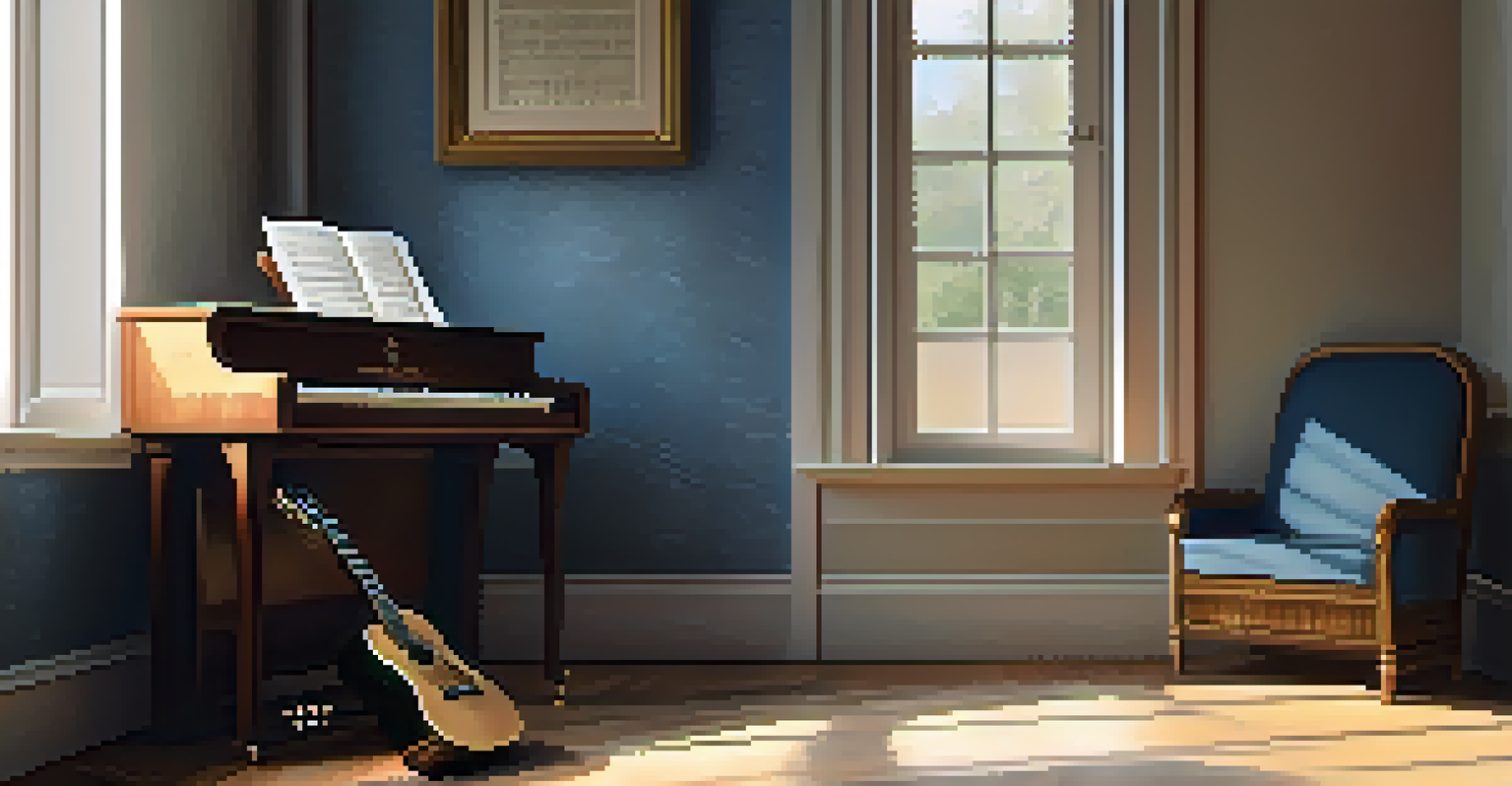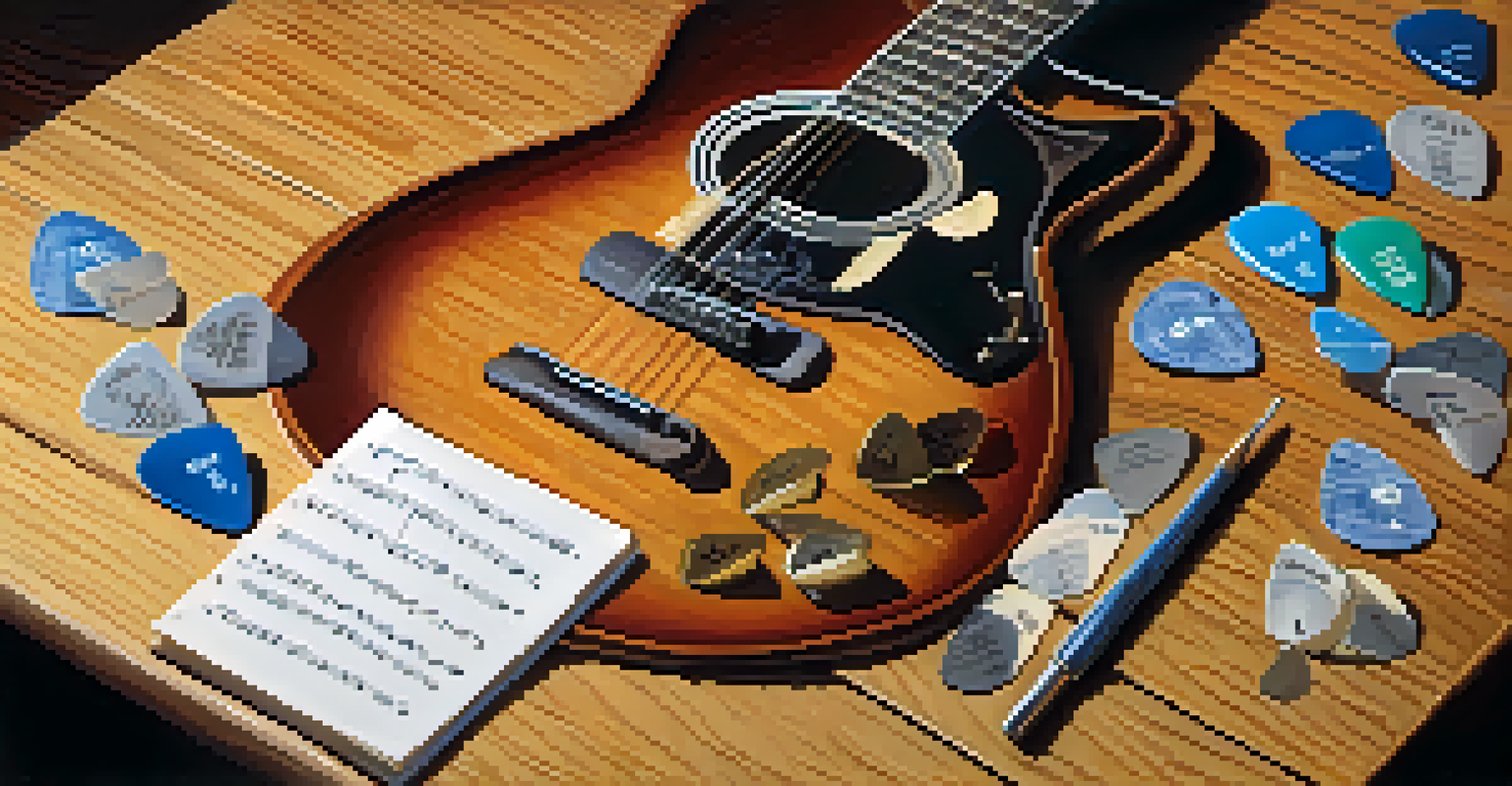The Blues Scale: Patterns and Their Role in Guitar Playing

What is the Blues Scale and Why It Matters
The blues scale is a musical scale that adds flavor and emotion to your guitar playing. It's made up of six notes: the root note, minor third, perfect fourth, augmented fourth (or diminished fifth), perfect fifth, and minor seventh. This combination creates a sound that captures the essence of blues music, making it a favorite among guitarists.
The blues is the roots; the roots are the blues.
Understanding the blues scale is key to improvisation, as it helps you express feelings and connect with your audience. It’s like having a secret language that allows you to communicate through your instrument. Whether you’re playing a soulful ballad or a fiery rock solo, the blues scale provides a framework for emotional expression.
Moreover, mastering this scale can open doors to various genres, including rock, jazz, and country. As you explore the blues scale, you'll find it enhances your musical vocabulary, enabling you to craft solos that resonate with listeners. So, let’s dive deeper into the patterns that make this scale so special.
Basic Patterns of the Blues Scale
The blues scale consists of several patterns that can be played across the fretboard. A common pattern starts on the low E string, where you can play the root note and follow the scale's intervals. By practicing these patterns, you’ll build muscle memory, allowing you to play the scale fluidly during solos.

One effective way to practice is to visualize the scale in different positions on the neck. For example, if you start with the A blues scale, you can shift the same pattern up to B, C, and so on. This approach helps you understand the relationships between notes and enhances your ability to improvise across the fretboard.
Understanding the Blues Scale
The blues scale is essential for emotional expression and improvisation in various music genres.
As you become familiar with these patterns, you can experiment with different rhythms and techniques, such as bends and slides. This experimentation will add your personal touch to the scale, making it uniquely yours. Remember, the goal is not just to play the notes but to make them sing!
Using the Blues Scale in Improvisation
Improvisation is where the blues scale truly shines. By incorporating this scale into your solos, you can create phrases that evoke strong emotions. Think of it as a painter using different colors to convey a mood on canvas; the blues scale offers a palette of notes to express your feelings.
Music can change the world because it can change people.
To effectively use the blues scale in improvisation, start by jamming along with backing tracks. This practice allows you to experiment with different phrases and develop your unique sound. Don’t be afraid to make mistakes; they often lead to unexpected and beautiful musical moments.
Additionally, listening to blues legends can inspire your improvisational style. Pay attention to how they integrate the blues scale into their solos. By analyzing their techniques and incorporating them into your playing, you’ll develop a deeper understanding of the scale’s expressive potential.
Connecting the Blues Scale to Chord Progressions
The magic of the blues scale lies in its connection to chord progressions. Most blues songs follow a simple pattern, often based on the I-IV-V chords. By recognizing these progressions and applying the blues scale, you can create solos that complement the underlying harmony.
For instance, if you’re playing over a 12-bar blues in A, you can use the A blues scale to improvise over the entire progression. This connection allows you to create melodies that feel cohesive and musically satisfying. It’s like being part of a conversation where your guitar responses naturally follow the chord changes.
Improvisation Techniques
Incorporating the blues scale into your solos allows you to create phrases that resonate emotionally with listeners.
Understanding this relationship also helps you anticipate changes in the music, allowing you to craft phrases that enhance the overall feel of the song. This skill will not only improve your solos but also make you a more versatile guitarist capable of adapting to different musical situations.
Common Mistakes When Using the Blues Scale
While the blues scale is a powerful tool, many guitarists make common mistakes when using it. One frequent error is playing the scale too mechanically, which can sound lifeless. Remember, the goal is to infuse emotion into your playing, so focus on phrasing and dynamics instead of just hitting the right notes.
Another mistake is neglecting the importance of rhythm. The blues is as much about the feel as it is about the notes. Experiment with different rhythms and syncopation to add interest to your solos. Think of it like dancing; the movement is just as crucial as the steps you take.
Lastly, some guitarists limit themselves to one position on the neck. While it’s essential to master that area, be sure to explore other positions as well. This exploration will expand your comfort zone and enable you to access a broader range of musical ideas.
Advanced Techniques with the Blues Scale
Once you’ve grasped the basics of the blues scale, it’s time to explore advanced techniques that can elevate your playing. Techniques like bending, sliding, and hammer-ons can add depth to your use of the scale. For example, bending a note can create a soulful, expressive sound that captures the essence of the blues.
Additionally, incorporating chromatic passing tones can enhance your solos. This involves using notes that are not part of the blues scale to transition between scale notes. These subtle additions can create tension and release, making your solos more engaging to the listener.
Common Mistakes to Avoid
Many guitarists struggle with mechanical playing and neglecting rhythm, which can diminish the expressive quality of the blues scale.
Finally, consider studying the styles of famous guitarists who utilize the blues scale. By analyzing their approaches and techniques, you can find inspiration to develop your own style. Remember, the blues scale is a foundation, and how you choose to build upon it defines your unique voice as a guitarist.
Practice Tips for Mastering the Blues Scale
To truly master the blues scale, consistent practice is essential. Set aside dedicated time to focus on playing the scale in various positions and tempos. You can start slow, ensuring accuracy, and gradually increase your speed as you become more comfortable.
Incorporating backing tracks into your practice routine can also be beneficial. This not only provides a musical context but also helps you develop your improvisation skills. Playing along with other instruments creates a dynamic environment that challenges you to adapt and respond musically.

Lastly, consider recording your practice sessions. Listening back can give you valuable insights into your playing. It allows you to identify areas for improvement while also celebrating your progress. With dedication and creativity, you’ll soon find the blues scale becoming a natural part of your guitar playing.